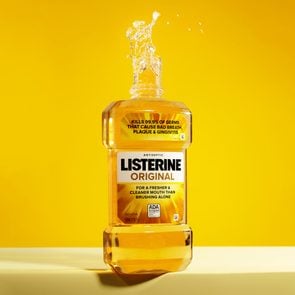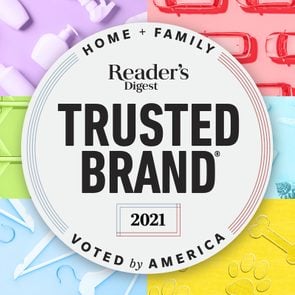How Tums Antacid Became America’s Most Trusted Brand
Updated: Feb. 01, 2024
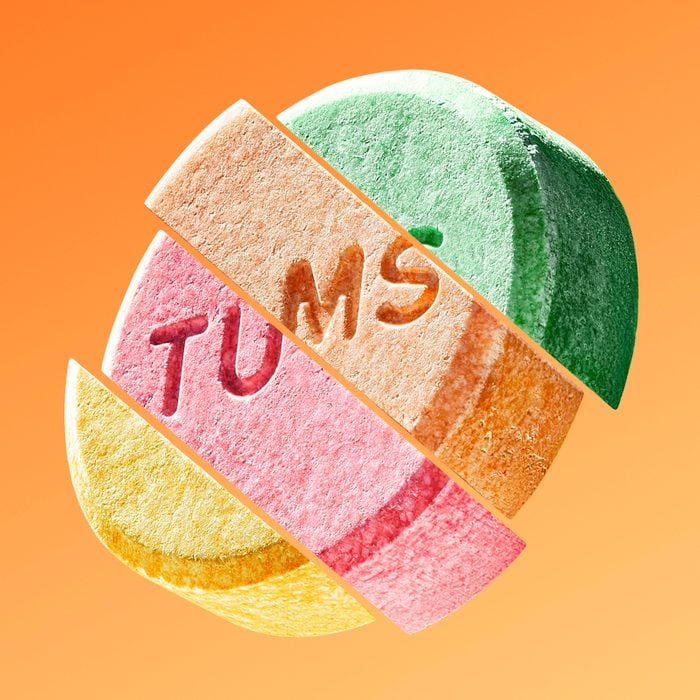
These tiny tablets have been providing relief to overfull tummies for nearly a century, earning them the top spot on Reader's Digest's Most Trusted Brands list.
Think of the roaring twenties, and most of the things that come to mind are long gone—flappers, speakeasies, Model Ts. But one classic is still with us, virtually unchanged: those little rolls of post-meal relief we call Tums.
Created in 1928 and brought to market two years later, Tums were part of a wave of early-20th-century consumer product innovations that included Scotch tape, Wonder bread, and Hostess Twinkies. Like those staples, Tums remains a best seller. In fact, it’s the top-selling brand-name antacid tablet in the nation; the company says it outsells Rolaids by almost two to one.
Even before the pandemic, sales were on the rise, and during the pandemic, some varieties were in short supply—unsurprising, since the 4,000 people we polled in our annual Trusted Brands survey put Tums at the top of their list of chosen antacids. While Tums now come in many varieties—with new twists on the original including gummies, smoothie flavors, and Naturals with no artificial flavors or coloring—the basic formula of calcium, sugar, and starch hasn’t changed.
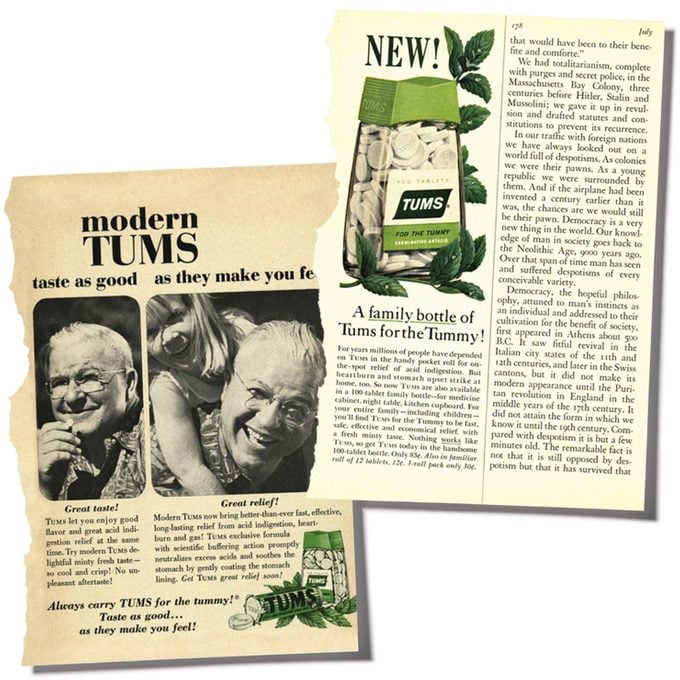
How do Tums work?
Those three simple ingredients translate into relief from a meal that’s left you miserable by turning your roiling, boiling stomach acid into water. Typical indigestion, heartburn, or “sour stomach” is caused by rich or spicy foods, which stimulate that acid. It’s a problem people have grappled with for thousands of years. The ancient Sumerians of southern Mesopotamia recorded their cure on clay tablets: sodium bicarbonate (better known as baking soda) mixed with milk and peppermint.
All antacids, both ancient and modern, use what chemists call a base. Acids and bases are two of the building blocks of chemistry. Acids contain hydrogen ions, and bases contain hydroxide ions. Put the two together, and their ions bond to form H2O, or water. Different antacids rely on different bases, but they all work the same way, bringing hours-long relief starting within five to ten minutes.
Before Tums, most antacids came as powders (to be mixed with water), or as liquids such as Maalox, whose base is magnesium hydroxide, and Pepto-Bismol, which uses bismuth salts. Until the 1950s, Americans could even buy an antacid made from papaya enzymes: Johnson & Johnson’s Papoids, which, along with Tums, was one of the first to come in easy-to-pop tablet form. But while Papoids became obsolete, Tums have stood the test of time, thanks, in part, to their loyal customer base.
Fascinating facts about Tums
Now that you know what Tums are for and how they work, it’s time to learn a little bit more about them. Check out these interesting facts about America’s favorite post-feast relief:
The first Tums were a gift from a husband to his wife
Tums were invented by James Howe, a Missouri pharmacist, who made them for his wife, Nellie Howe. The two were preparing for a cruise, notorious then, as they are now, for loading down passengers with food and drink. (Funnily enough, Indiana chemist and Alka-Seltzer inventor Hub Beardsley brought his own tablets of baking soda and aspirin on a Mediterranean voyage that same year.) But the product’s name came from a nurse at a local military base, Jefferson Barracks, through a company-sponsored radio contest.
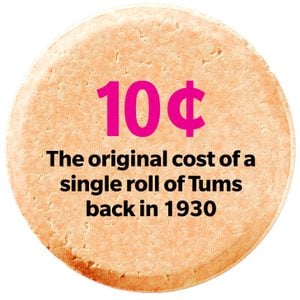
Tums’ initial price tag? Just a dime
Tums were originally sold in gold-colored tubes labeled “Tums for the Tummy.” That slogan was soon found on a range of promotional items including dessert spoons, calendars, clocks, and even tape measures.
The advertising has always been catchy
Early Tums ads included catchphrases such as this and “Like Good Food? Don’t Appear Rude: Always Carry Tums” and “Even Hamburger Doesn’t Faze Me Now.” The company advertised on matchbooks, suggesting that the tablets be used “After Eating, Drinking, Smoking.” The now-famous “Tums, Tum-Tum-Tum, Tums!” song debuted in 1981.
What are Tums made of?
If Tums have a chalky consistency, it’s because they’re literally made of chalk. Their base is calcium carbonate, a form of mineral calcium found in limestone, chalk, and marble.
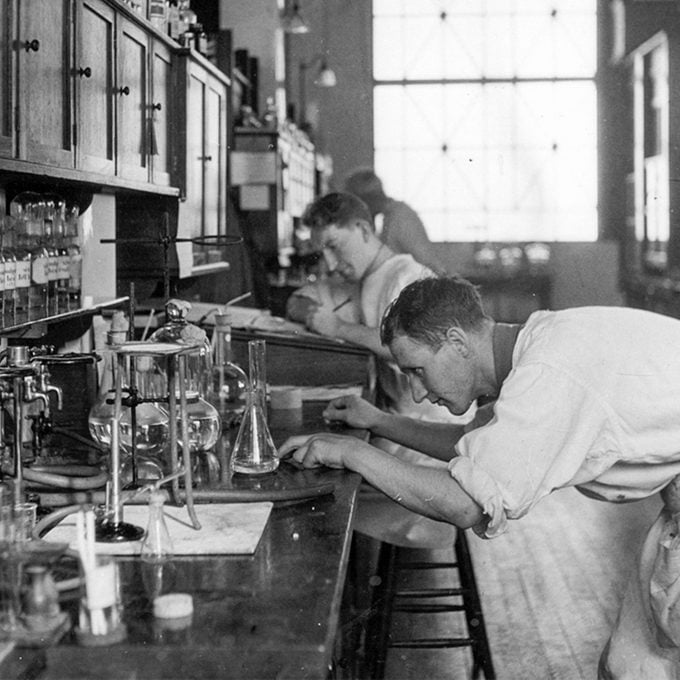
Tums start out as 2,000-pound super sacks
Those sacks contain a ton of sugar and calcium carbonate, which are mixed with water and starch. When the mix dries, it is fed into powerful compressors that squeeze it into tablets, using about five tons of force. Each of the Tums factory’s 27 “tablet stations” can spit out up to 2,500 tablets a minute. They’re then bottled or rolled up, and shipped around the world.
The Tums factory is a St. Louis landmark
Those tablets have been churned out of the same factory since day one. The factory’s seven interconnected buildings take up a full city block. It’s one of the last major manufacturers left in what was once a Midwestern industrial powerhouse.
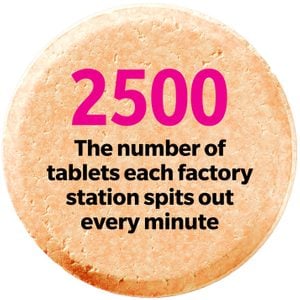
Workers have been known to pop them like candy
At that factory, according to the Associated Press in 2004, “the tasty tablets sit in jars and bowls on desks. Workers will occasionally pop a couple into their mouths as a snack. ‘It’s almost like candy to us,’ plant manager Glen Giles said.” In Chicago, one bartender actually made a cocktail out of the medicine: Gary Matthews of Drumbar mixed fruit-flavored Tums with a rogue’s gallery of gut-boilers including cream, egg whites, red pepper, and some spicy sausage oil. “I wanted to make something that could potentially give someone heartburn and at the same time cure their heartburn,” he said.
Today, the company sponsors some serious challenges
The Tums team’s mission these days is to win over customers by challenging “adventurous” eaters to give themselves heartburn. Tums recently sponsored a YouTube series called “Hot Ones,” which features celebrities sampling specialty hot sauces with such names as Hell Fire Detroit, Beyond Insanity, and the Puckerbutt Pepper Company’s Chocolate Plague. The company also gave away thousands of spicy chicken wings, part of a campaign called “Tums or Dare,” aimed at people who like to eat hot stuff.
Snails gobble Tums, too
Tums have some unusual fans: snails. The calcium in Tums tablets is exactly what the slow crawlers need for strong, healthy shells. So owners regularly plop a few Tums tablets into their snail tanks to keep them happy, or grind them up to make the food they call “snail Jell-O.” Snails love the stuff, owners say, but they recommend sticking with fruit flavors. The minty ones will burn a snail’s foot.
Next, check out the other health and wellness brands that made Reader’s Digest’s Trusted Brands list in 2022.
